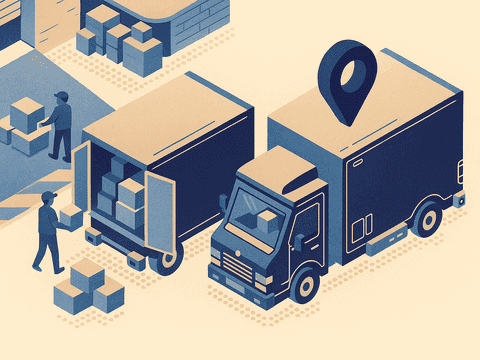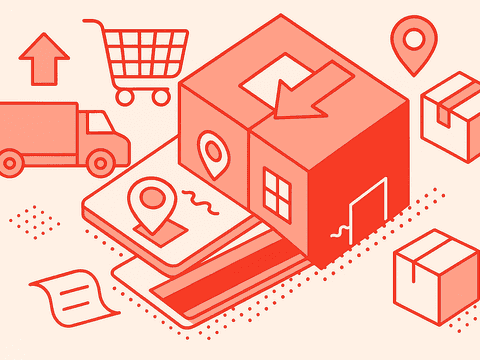Looking for an eCommerce delivery management solution?
If you want to retain customers and sustainably increase profits, it’s essential to ensure that your orders are delivered on time while avoiding unnecessary costs.To achieve this, you’ll need delivery management software for your eCommerce.
Delivery management solutions play a fundamental role in eCommerce logistics, covering aspects such as order tracking, shipping label automation, and effective communication with both customers and carriers.
In this article, we explore the best options, tools, and platforms for managing your eCommerce deliveries.
Top-rated delivery software for last-mile management in eCommerce and retail
| Tool | Best For | Key Features | G2 Rating |
|---|---|---|---|
| Outvio | All-in-one post-purchase operations | AI automation, tracking upsells, returns/exchanges, branded notifications, carrier integration | 4.8 |
| ShippyPro | Label printing and shipping tracking | Carrier integrations, label printing, returns management, customizable interface | 4.5 |
| Trakop | Last-mile delivery | Route tracking, delivery automation, last-mile optimization, promotional banners | 4.8 |
| FarEye | Enterprise delivery optimization | Dynamic routing, workflow automation, parcel tracking, logistics analytics | 4.7 |
| ShipStation | Multi-channel shipping sync | Multi-channel integration, basic tracking, label printing, mobile access | 4.3 |
| EasyShip | Cross-border rate calculations | Real-time shipping rates, label printing, basic order tracking, analytics | 4.0 |
| AfterShip | Modular tracking and returns | Customizable notifications, returns management, tracking portal | 4.6 |
| Sendcloud | Small shops with basic needs | Shipping & returns, branded tracking, self-service returns portal, label printing | 4.7 |
| Detrack | Fleet delivery tracking | Real-time tracking, electronic proof of delivery (ePOD), fleet and driver management | 4.5 |
What is eCommerce delivery management?
Ecommerce delivery management refers to the process of planning, controlling, and optimizing the movement of products from the point of sale to the end customer. It includes tracking, managing delivery times, and ensuring the delivery experience is smooth and on-time.
What is eCommerce delivery management software?
A delivery management software is a tool designed to help businesses manage their delivery operations more efficiently.
It provides features like real-time tracking, communication with drivers, delivery notifications, and analytics. This software centralizes delivery tasks, enabling businesses to scale operations, improve delivery speed, and reduce logistical errors.
Benefits of using a delivery management solution
- Automates shipping scheduling, tracking, and dispatching to cut down on manual tasks
- Reduces delays and improves order processing speed
- Increase repeat purchases by promoting additional products throughout the delivery experience
- Shortens delivery times by automatically assigning the nearest driver
- The most advanced delivery management software can automate exchanges and returns management
When an eCommerce business should integrate a delivery solution
Integrating a delivery management solution is crucial for eCommerce businesses aiming to scale, expand, and enhance the customer experience. As orders grow, automating shipping reduces errors and processing time, helping manage peak demand effectively.
Delivery solutions also enable data-driven carrier selection, potentially lowering costs by up to 20%, as McKinsey notes. Improved tracking transparency strengthens customer trust, a strategy that has driven repeat purchases for brands like Zara.
Optimized logistics also provide a competitive edge; Deloitte reports companies prioritizing fast, flexible delivery see retention rates up to 60% higher.
Here are some symptoms that may indicate an eCommerce business needs to integrate a delivery management solution:
- Frequent shipping errors indicate a need for automation
- Rising costs suggest data-driven carrier selection is needed
- High “Where’s my order?” inquiries reveal a lack of real-time tracking
- Struggles with peak demand highlight inefficient fulfillment workflows
- Low retention rates may result from inconsistent delivery times
- International growth plans require automated tariff and documentation handling
- Falling behind competitors on delivery speed signals a need for optimized logistics
Best eCommerce delivery management tools and solutions
1. Outvio
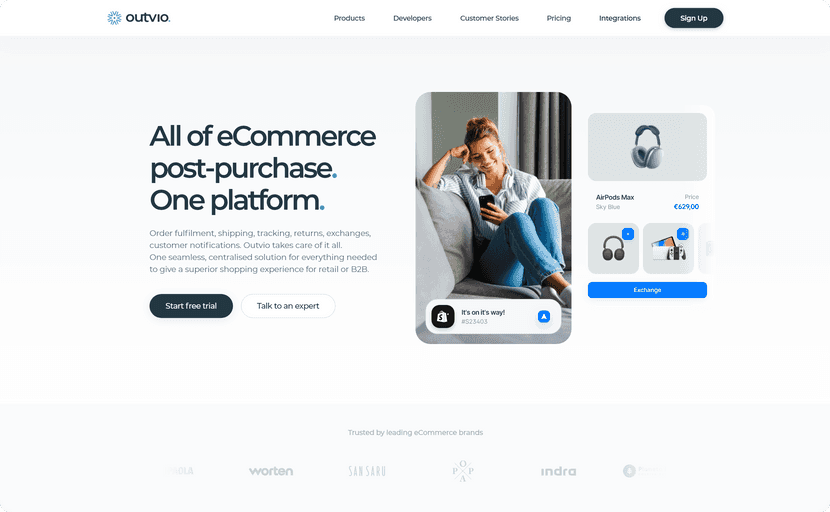
Outvio is a premium delivery management software for eCommerce that allows you to automate and optimize all order processes. Among its many features are intelligent courier and shipping rules, automations powered by AI, self-service management of returns and exchanges, and the ability to add offers on tracking pages and customer notifications to create cross- and up-selling possibilities.
Outvio is an all-in-one platform used by top brands to ensure efficient operations at all times. If you choose this solution, you won't have to worry about looking for alternative tools.
G2 Rating
Key features
- Unify your entire eCommerce operation: deliveries, returns, logistics, and customer support.
- Direct integration with national and international carriers
- Automation of all post-payment processes powered by AI
- Sending of personalized notifications via WhatsApp, email, and SMS
- Tracking portal with cross-selling capabilities to generate revenue
- Automatic resolution of transportation and delivery incidents
- Fully automated returns and exchanges
- Dashboard with delivery, return, and transportation analytics
Starting price: $125/month
URL: Outvio

2. Shippy Pro

ShippyPro is a popular delivery management solution for eCommerce. While it doesn’t offer as many automation and marketing features, it effectively optimizes delivery routes. ShippyPro enables users to print labels, track shipments, and manage return requests efficiently.
G2 Rating
Key features
- Large number of carrier integrations
- Ability to print shipping labels and includes a tracking system
- An intuitive tool with a high degree of customization
- Simplify the returns process
- Access detailed insights into shipping performance
Starting price: $220/month
URL: ShippyPro
3. Trakop
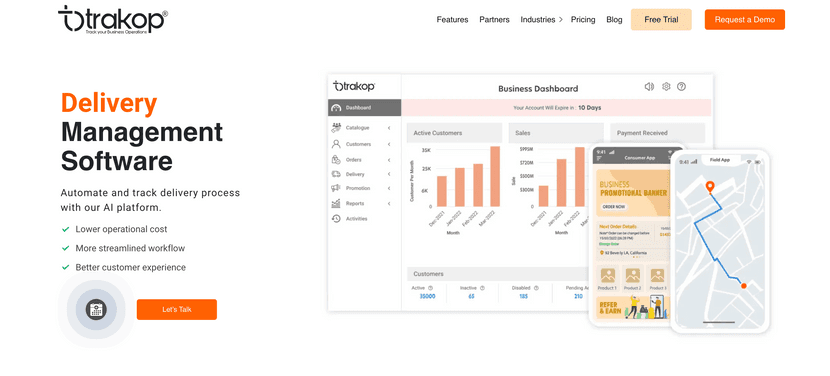
Trakop is a software specialized in last-mile delivery. It helps with the shipping process and product tracking from the warehouse to the end customer.
As we say, it is an exclusive delivery management solution for last-mile logistics, so it is not a good option for eCommerce that prefer a complete order management.
G2 Rating
Key features
- Shipping automation
- Delivery route tracking
- Allows you to add promotional banners
- Route optimization
Starting price: $49/month
URL: Trakop
4. ShipStation
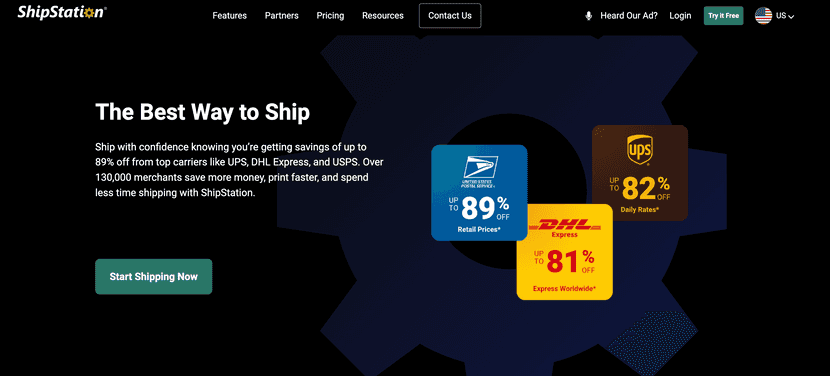
ShipStation is another delivery management tool for eCommerce. The tool is specialized in connecting sales channels with warehouses and carriers.
This software is recommended if you need to print labels or provide basic tracking to the buyer. However, its advanced features may be insufficient for eCommerce with a more complex shipping operation.
G2 Rating
Key features
- Allows integration of multiple sales channels
- Delivery tracking
- Notification system
- Mobile accessibility
Starting price: $9.99/month
URL: Shipstation
5. EasyShip
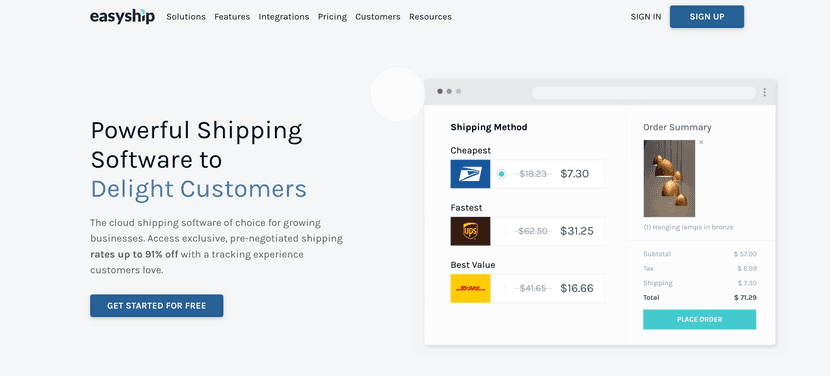
EasyShip is a similar alternative to ShipStation. In addition to connecting carriers and sales channels, this delivery management software for eCommerce also offers label printing, tracking, and notification services. However, its options for customization, automation, and cross-selling are limited.
G2 Rating
Key features
- Real-time shipping rates
- Analytics and reporting
- Prints shipping labels
- Basic order tracking
- Carrier integration
Starting price: $29/mo
URL: Easyship
6. AfterShip
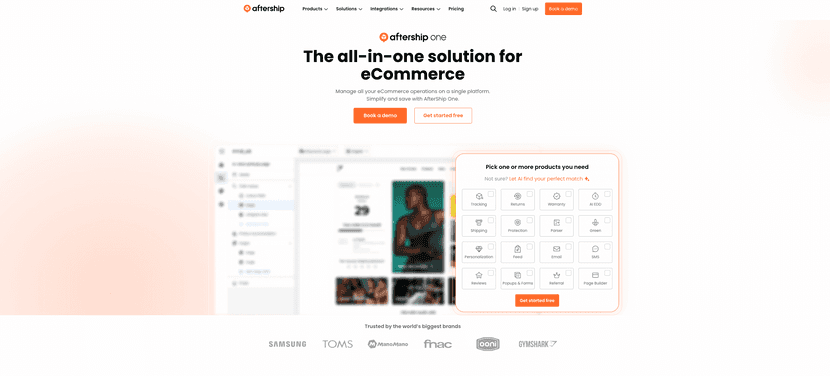
AfterShip is an eCommerce platform divided into modules. It offers a fairly complete solution for delivery or return management. However, if you want to enjoy all the features, you will have to integrate all the modules.
If you want to use all modules for a complete experience, this eCommerce delivery management software can be quite costly.
G2 Rating
Key features
- Efficient carrier management
- Customizable notifications
- Tracking portal
- Returns management
- Marketing and notifications
Starting price: Depends on the selected module
URL: AfterShip
7. Sendcloud
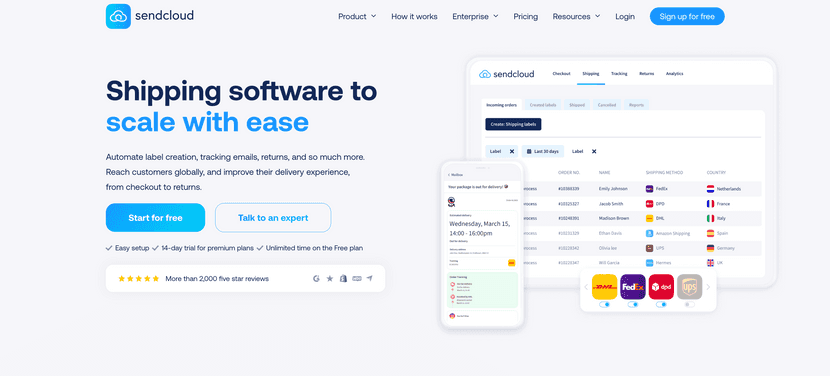
Sendcloud is another tool that you can use to manage the deliveries of your online store. It is characterized by its free plan, which covers everything from shipping to returns and tracking. Sendcloud is a very good option if you have just created your first store and need software to process your first orders, as it will be very economical for you.
G2 Rating
Key features
- Free plan
- Shipping and returns management
- Self-service returns portal
- Branded tracking notifications
- Label printing
Starting price: €25/month
URL: Sendcloud
8. FarEye

FarEye is a logistics and delivery management platform designed to help businesses streamline and optimize their delivery operations. It offers solutions for last-mile delivery, parcel tracking, and route optimization, all aimed at improving efficiency and enhancing customer satisfaction.
G2 Rating
Key features
- Dynamic Routing
- Automated Workflow Management
- Parcel tracking
- Analytics and reporting
Starting price: Custom
URL: FarEye
9. Detrack
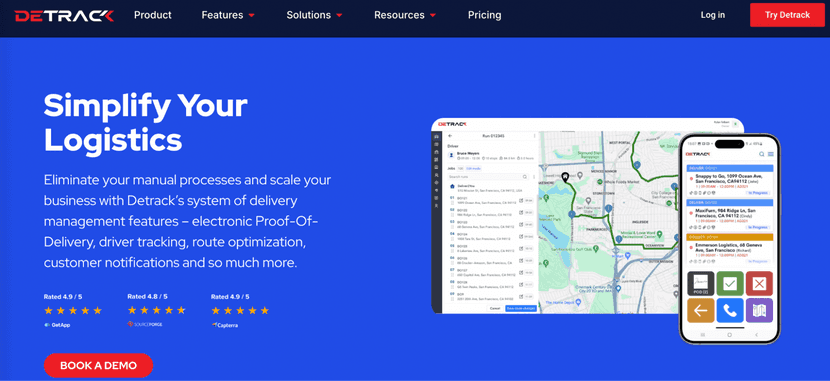
Detrack is a cloud-based delivery management software designed to streamline logistics operations for businesses of all sizes. It offers real-time tracking, electronic proof of delivery (ePOD), and route optimization to enhance efficiency and customer satisfaction.
G2 Rating
Key features
- Electronic proof of delivery (ePOD)
- Customer notifications
- Fleet management
- Order tracking
Starting pricing: €29/vehicle per month
URL: Detrack
4 Practices for a successful eCommerce delivery strategy
1. Use Automatic shipping rules to celect the best carrier
Setting up automatic shipping rules allows the system to intelligently choose the best carrier for each order without manual intervention.
You can create rules based on factors like destination, desired delivery time, product type, or even order value.
This way, if a customer needs a quick delivery, the system can automatically select an express carrier. For local deliveries that aren’t urgent, it can opt for a more economical, local service.
Benefit: This ensures that each order is handled in the most efficient and cost-effective way without the need for someone to review each case. It also improves accuracy and reduces processing times.
2. Increase the number of shipping options at checkout
Offering multiple shipping options at checkout allows customers to pick the one that best fits their needs, whether it’s express, standard, or economical shipping.
This flexibility enhances the shopping experience and helps reduce cart abandonment.
Customers appreciate having choices—especially when they can select faster delivery for an extra fee or choose a budget-friendly option if they’re not in a hurry.
Benefit: Providing choices increases customer satisfaction and builds trust in the purchasing process, which can lead to a higher conversion rate. Customers feel more in control of their purchase, which reduces the likelihood of them abandoning their cart at this crucial stage.
3. Send personalized notifications
Personalized notifications, in addition to keeping customers updated on their shipping status, are an excellent opportunity to offer promotions or related products that might interest the customer.
For instance, once an order is on its way, you can send an update message that includes a special offer or a discount on complementary products.
Benefit: These notifications keep customers engaged with your store beyond their initial purchase. When a customer is waiting for their order, it’s an ideal time to capture their attention and encourage them to explore additional products, which can translate into more sales.
4. Turn returns into new sales with
Instead of handling returns traditionally, you can offer customers the option to receive store credit in exchange for their return, incentivizing them to make another purchase rather than requesting a refund.
Additionally, you can allow customers to exchange the returned product for a higher-value item by paying the difference, turning a negative experience into a sales opportunity.
Benefit: By offering store credit instead of refunds and making exchanges easier, you can retain more revenue and improve the customer experience. This also increases the likelihood that customers will make a higher-value purchase since they’re already invested in your store and less likely to look for options elsewhere.
How to choose the best delivery management software for eCommerce
Here are some factors to consider when choosing eCommerce shipping software that will truly boost your eCommerce:
- Cross-selling: Look for tools that offer the ability to incorporate cross-selling strategies. This can increase sales by showing customers related products during the checkout process.
- Third-party integrations: Avoid solutions that require numerous integrations with other services or applications. Each integration comes with additional costs and unnecessary complications.
- Automation: Make sure it has truly effective automation methods. This can help save time and money.
- Automatic product exchanges: The tool should allow you to set up automatic exchanges for any other product in the catalog. This will help you reduce returns and increase your passive income through exchanges for higher-value products.
- Transportation incident resolution: Look for software that provides you with tools to resolve shipping issues efficiently. This can save money and improve customer satisfaction.
- Single shipping charge: Opt for software that allows you to apply a single shipping charge per order instead of charging per printed label. This will simplify the cost structure and help reduce order processing fees.
Choosing the best delivery management software for eCommerce can be a complex task. By keeping the factors mentioned in mind, you can save money and improve the efficiency of your shipping operations.
How much do the best eCommerce delivery management solutions cost in 2025?
| Tool | Key Features | Starting Price | Trial Period |
|---|---|---|---|
| Outvio | Comprehensive solution with AI-powered automation, cross-sell on tracking, full returns management | $125/month | Yes |
| ShippyPro | Carrier integrations, label printing, customizable | $220/month | Yes |
| Trakop | Last-mile tracking, route optimization | $49/month | No |
| FarEye | Dynamic routing, workflow automation | Custom | No |
| ShipStation | Multi-channel, basic tracking, mobile access | $9.99/month | Yes |
| EasyShip | Shipping rates, label printing, carrier integration | $29/month | Yes |
| AfterShip | Modular tracking & returns, customizable notifications | Module-based | Yes |
| Sendcloud | Shipping & returns, free plan, branded notifications | €25/month | Yes |
| Detrack | Real-time tracking, ePOD, fleet management | €29/vehicle/month | Yes |


